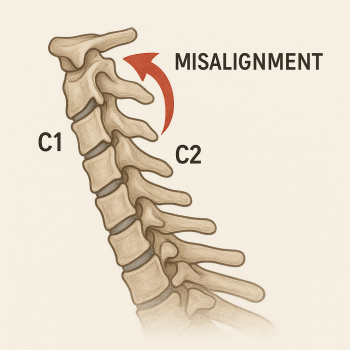
If you’ve been living with chronic neck pain, you’ve probably tried everything, stretching, massage, better pillows, maybe even medication. But if that stubborn ache keeps coming back, the root of your discomfort might be hiding at the very top of your spine: the C1 vertebra, also known as the atlas.
At Dr. Thomas Forest’s upper cervical chiropractic clinic in Pleasanton, we often find that long-term neck pain isn’t just a muscle issue, it’s a structural problem involving misalignment of the atlas, the small yet critical vertebra that supports your head and protects vital nerves.
Why the C1 (Atlas) Matters
The C1 vertebra sits at the top of the spine, connecting the head to the neck and surrounding the brainstem, a command center that controls balance, coordination, and even muscle tone. When the C1 shifts out of its natural position, it can disrupt nerve flow between the brain and body.
According to neuroanatomy studies, this misalignment can lead to muscle tension, reduced range of motion, nerve irritation, and secondary pain throughout the shoulders, back, and head. Even a slight tilt of the atlas can alter posture, affect blood circulation to the brain, and strain the entire spinal system.
Common Symptoms of C1 Misalignment
You might not immediately connect your symptoms to the upper cervical spine, but C1 imbalance often causes:
- Persistent neck pain or stiffness that returns after short-term relief
- Headaches or migraines, especially at the base of the skull
- Shoulder tightness or one shoulder sitting higher than the other
- Jaw discomfort (TMJ) or facial tension
- Dizziness, vertigo, or balance problems
- General fatigue or difficulty concentrating
If these sound familiar, your neck pain may not be “just muscular.” It could be a sign of neurological interference stemming from a misaligned atlas.
The C1 and Your Nervous System
The upper cervical spine protects the lower brainstem and spinal cord, regions essential for communication between your brain and body. When alignment shifts, it can irritate or compress the nerves that control everything from posture to pain response.
Upper cervical chiropractic care focuses on restoring this alignment with precision and gentleness, improving nerve function without aggressive twisting or cracking. Once the pressure is removed, the body can begin to heal naturally, reducing inflammation and restoring balance.
Upper Cervical Chiropractic Care in Pleasanton, CA
At Dr. Thomas Forest’s clinic on Stanley Blvd in Pleasanton, care begins with advanced digital imaging to analyze the exact position of your C1 and C2 vertebrae. Using this data, Dr. Forest designs a customized adjustment plan to bring your spine back into balance.
Most patients describe these adjustments as light, precise, and surprisingly comfortable. The results, however, can be life-changing, many report lasting relief from neck pain, better posture, and improved energy levels after restoring their atlas alignment.
Real Relief Starts at the Top
Ignoring upper cervical misalignment can allow neck pain to become chronic and affect your entire body mechanics. But the good news is, correcting the problem doesn’t require medication or surgery, just focused, expert care that addresses the true cause.
If you’re tired of chasing temporary fixes for your neck pain, it’s time to check your C1 alignment.
Schedule a consultation today with Dr. Thomas Forest
Office: (925) 846-3357
Visit our website







Leave a comment